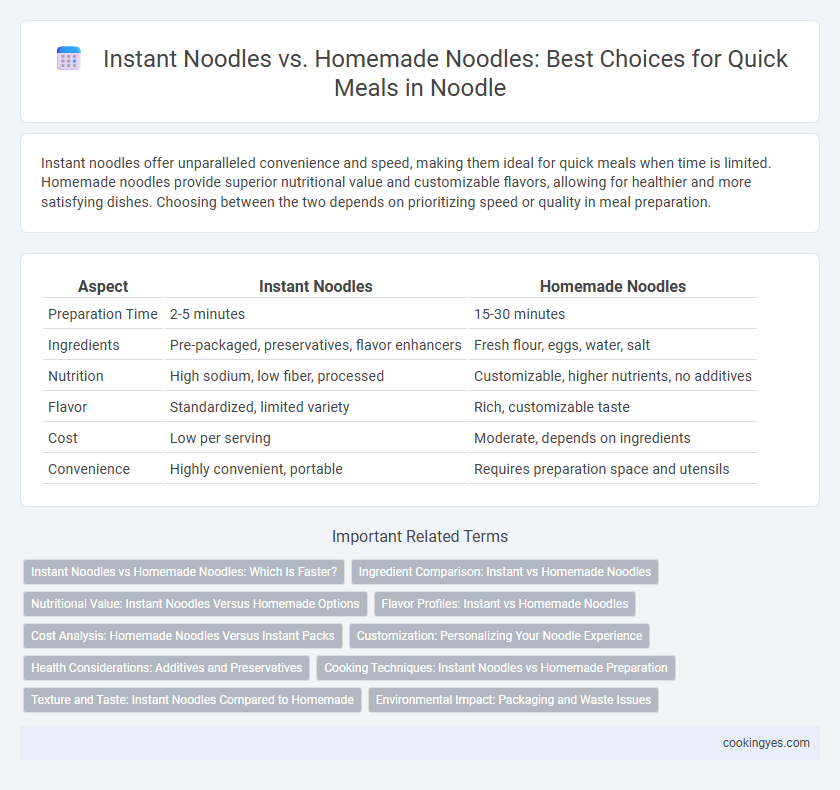Instant noodles offer unparalleled convenience and speed, making them ideal for quick meals when time is limited. Homemade noodles provide superior nutritional value and customizable flavors, allowing for healthier and more satisfying dishes. Choosing between the two depends on prioritizing speed or quality in meal preparation.
Table of Comparison
| Aspect | Instant Noodles | Homemade Noodles |
|---|---|---|
| Preparation Time | 2-5 minutes | 15-30 minutes |
| Ingredients | Pre-packaged, preservatives, flavor enhancers | Fresh flour, eggs, water, salt |
| Nutrition | High sodium, low fiber, processed | Customizable, higher nutrients, no additives |
| Flavor | Standardized, limited variety | Rich, customizable taste |
| Cost | Low per serving | Moderate, depends on ingredients |
| Convenience | Highly convenient, portable | Requires preparation space and utensils |
Instant Noodles vs Homemade Noodles: Which Is Faster?
Instant noodles typically cook in 3 to 5 minutes, making them the fastest option for quick meals compared to homemade noodles, which require 30 to 60 minutes for dough preparation, rolling, and cooking. The preparation time for homemade noodles involves mixing ingredients, kneading, resting, and boiling, which significantly extends the total cooking process. Therefore, instant noodles offer a convenient and time-saving solution for busy individuals seeking immediate meal options.
Ingredient Comparison: Instant vs Homemade Noodles
Instant noodles typically contain preservatives, artificial flavorings, and high sodium levels to extend shelf life and enhance taste, while homemade noodles use fresh ingredients like flour, eggs, and water, allowing for better control over nutritional content and flavor. The instant variety often lacks fiber and essential nutrients found in homemade versions, which can incorporate whole grains and fresh vegetables. Choosing homemade noodles supports a healthier, less processed meal option with customizable ingredients tailored to dietary needs.
Nutritional Value: Instant Noodles Versus Homemade Options
Instant noodles often contain higher levels of sodium, preservatives, and unhealthy fats compared to homemade noodles, which can be made with fresher, more nutritious ingredients like whole grain flour and vegetables. Homemade noodles provide greater control over nutrient content, allowing for the addition of protein-rich elements such as eggs or lean meats, enhancing their overall nutritional profile. While instant noodles offer convenience, homemade options typically deliver better balanced macronutrients and fewer artificial additives, making them a healthier choice for quick meals.
Flavor Profiles: Instant vs Homemade Noodles
Instant noodles often feature a bold, salty, and umami-rich flavor due to seasoning packets designed for convenience and intense taste. Homemade noodles deliver a fresher, more nuanced flavor profile, allowing control over ingredients like broth richness, herbs, and spice levels that enhance overall taste complexity. The contrast between instant's artificial flavor boosters and homemade's natural ingredients significantly impacts the depth and authenticity of the noodle dish.
Cost Analysis: Homemade Noodles Versus Instant Packs
Homemade noodles typically cost less per serving compared to instant noodle packs, as basic ingredients like flour and eggs are inexpensive and yield multiple portions. Instant noodle packs, while convenient, often have a higher price per meal and include preservatives and added sodium, increasing the overall cost beyond just the monetary value. Evaluating cost-effectiveness, homemade noodles offer a budget-friendly option with better nutritional control for quick meal preparation.
Customization: Personalizing Your Noodle Experience
Instant noodles offer convenience but lack the flexibility to fully customize flavors, textures, and ingredients according to personal preferences. Homemade noodles allow complete control over noodle thickness, broth richness, and toppings, enabling a tailored meal that suits dietary needs and taste profiles. Customization in homemade noodles enhances nutritional value and provides a fresh, satisfying alternative to standard instant options.
Health Considerations: Additives and Preservatives
Instant noodles often contain additives and preservatives such as monosodium glutamate (MSG), tertiary butylhydroquinone (TBHQ), and sodium-based preservatives, which can impact long-term health when consumed frequently. Homemade noodles offer better control over ingredients, avoiding chemical additives and allowing for the use of fresh, nutrient-rich components like whole wheat flour and natural seasonings. Choosing homemade noodles reduces exposure to artificial additives, supporting a cleaner diet and potentially lowering risks of hypertension and allergic reactions.
Cooking Techniques: Instant Noodles vs Homemade Preparation
Instant noodles require minimal preparation, typically boiling the noodles in water for 3-5 minutes, making them ideal for quick meals. Homemade noodles demand more time and culinary skill, involving dough kneading, rolling, and precise cutting before boiling or frying. The cooking techniques for instant noodles prioritize convenience and speed, whereas homemade noodles emphasize texture, freshness, and customization.
Texture and Taste: Instant Noodles Compared to Homemade
Instant noodles offer a consistent, soft texture with a savory, often salty flavor designed for rapid preparation, while homemade noodles provide a chewier, more elastic bite with a richer, fresher taste due to the quality of ingredients and customization. The drying and frying process in instant noodles results in a slightly starchy mouthfeel, whereas homemade noodles, cooked immediately from fresh dough, maintain a more natural wheat aroma and complex texture variety. Taste differences are pronounced as homemade noodles can absorb sauces and broths more effectively, enhancing overall flavor depth compared to the uniform seasoning in instant varieties.
Environmental Impact: Packaging and Waste Issues
Instant noodles generate significantly more packaging waste due to single-use plastic cups and wrappers, contributing to environmental pollution and landfill overflow. Homemade noodles minimize waste by using reusable containers and fresh ingredients, reducing reliance on plastic and promoting sustainable cooking practices. Choosing homemade options supports eco-friendly meal preparation, lowering carbon footprints associated with instant noodle production and disposal.
Instant noodles vs homemade noodles for quick meals Infographic

 cookingyes.com
cookingyes.com